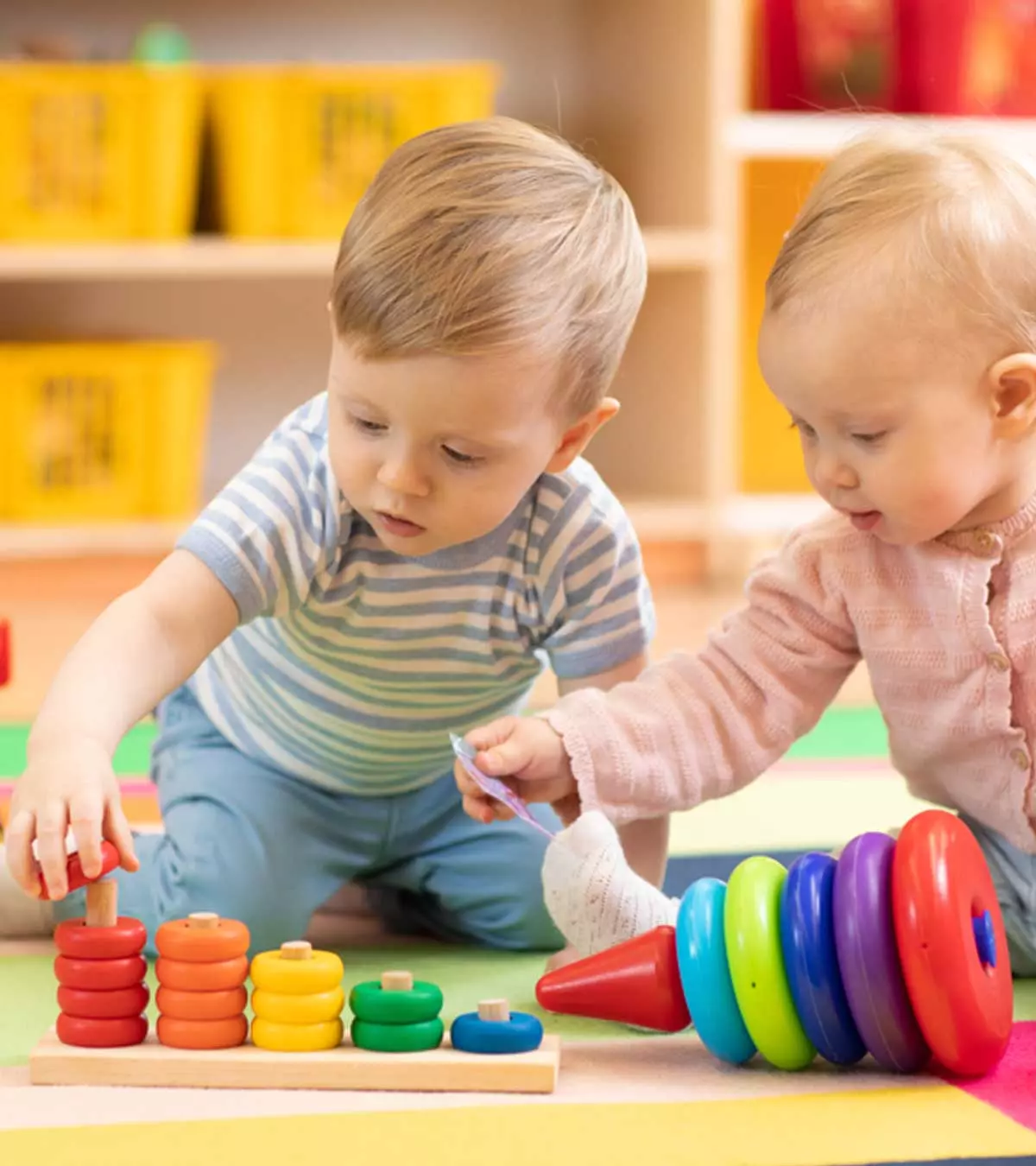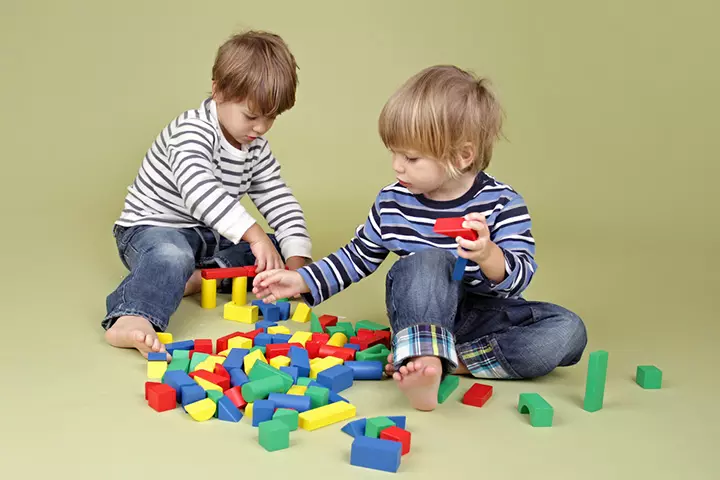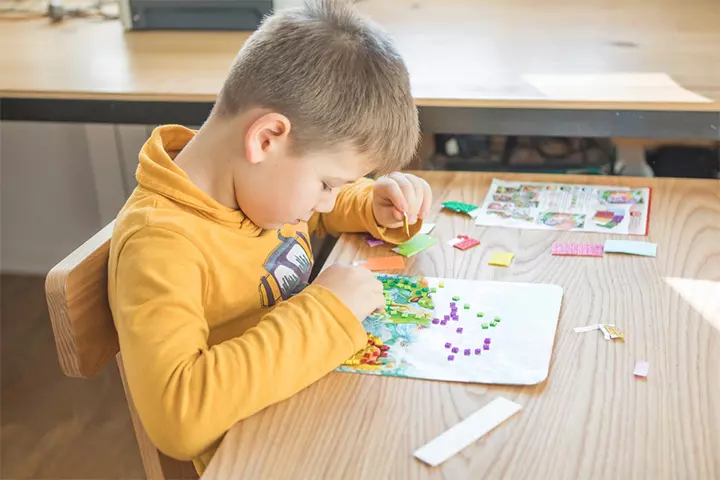
Image: Shutterstock
Children can stay engaged with various types of play, stimulating their brain development and skills. The preference may vary for each child, but when it comes to a fun activity and play, they are ready to explore and experience. Play can be any organized or unorganized activityiUnstructured or unplanned activity that allows a child to play freely without much instruction. that is enjoyable or exciting for children (1). All types of play, including playing with a ball, acting like a superhero, or just trying siblings’ clothes, could promote a child’s learning process and brain development.

Read on to know various types of play for children and their importance and benefits.
Key Pointers
- Engaging in different types of play helps children learn new things and understand social relationships.
- Playing hones a child’s cognitive, communication, social, and motor skills necessary for their overall development.
- Depending on their age, children pass different stages of play, such as unoccupied play, solitary play, and associative play.
Why Is Play Important For A Child’s Development?
Children usually learn new things and forge social relations by engaging in different types of play. It could help exercise a child’s problem-solving skills, risk-taking capabilities, creativity, conflict resolutioniA process of resolving a conflict between two or more people in a peaceful manner. , effective communication, and cooperation.
Playing may also affect various academic skills related to math, science, language, and reading (2). Since play affects multiple attributes, a child could experience physical, intellectual, and social development through play. Moreover, playing relaxes a child and strengthens their muscles (3).
The following are the effects of play on key areas of a child’s development (4).
- Gross motor skills development: Children learn motor skills, including balance, movement, and lifting objects. Physical plays help them stay active and healthy and strengthen their bones and muscles as they grow older.
- Fine motor skills development: Right from toddlerhood, certain games like sorting, beading, etc can help in tuning the child’s finer finger movements.
- Intellectual development: Play improves children’s reasoning, memory, and thinking. Interestingly, toddlers between the ages of two and three may learn to identify shapes and sizes, count, and enhance their imagination while playing.
- Social development: Children develop their personalities and become independent while playing. It can positively affect their social interactions. Also, they learn to care and become social or friendly.
Play activities need not be for a longer period of time. Multiple short durations of play spread across the day could be beneficial, as well. Also, if, as a parent, you are unable to spend time with your child, you may allow them to help you with household chores, such as cleaning. It could make for a playful way to teach your little one some essential skills (5).
Different Types Of Play
There are different types of play, depending on the way the child plays it. Most children prefer a type of play at a certain age. The following are the different types of play and their benefits (6).
1. Unoccupied play
Babies usually experience this type of play. It seems less like a play and more like experimentation. Babies are almost still, and their activities seem less integrated or organized. For instance, you may see babies just making a lot of movements with hands and legs. Incorporating sensory play into their activities can enhance their development and make playtime more engaging for them.
Benefits:
- In this type of play, babies explore the tangible materials around them and discover how their body works.
- They also learn to manipulate objects around them and self-control. It helps them prepare for future exploration.
2. Solitary play

This stage of free play occurs in toddlers often between two and three years of age. In solitary play, they engage in self-entertainment and don’t require anyone’s involvement. They also might not notice other toddlers. Parents may worry about their child’s self-isolation, but it is quite normal. A few examples of solitary play is when a toddler is alone and flips through a book, plays with Lego sets, or solves a puzzle.
Benefits:
- It prepares them to play with others in the future but, most importantly, makes them self-sufficient.
- When children play independently, they exercise their motor and intellectual skills.
 Point to consider
Point to consider3. Onlooker play
During onlooker play, the child acts as a spectator and observes other children engaging in social play, rather than actively participating. It is a normal stage in a child’s development and does not necessarily indicate that the child is hesitant and scared to engage with others..
Benefits:
- By watching, they learn about other children, the use of materials, and social interaction between people.
- They learn new ways to explore the world and manipulate objects by observing others.
4. Parallel play

It is when children play close to each other, but they don’t engage with one another. During parallel play, they learn to play without disturbing or affecting each other. An example of a parallel play activity for toddlers is when two children play with their respective toy cars but without interacting with each other.
The children might try to observe and copy each other out of curiosity. Another example is when a child goes near a group of children, picks a toy, and starts playing alone without talking or interacting with others.
Benefits:
- It appears more like a warm-up, that is, they are silently learning about different ways to engage or interact with others.
- This type of play also helps them practice their new skills.
5. Associative play
It is the first step towards learning to have fun with others. During associative play, the child is interested in doing the same activities or using the same toys as others but without interacting with other children. For instance, children playing on the same slide in the playground but each performing a different activity, such as sliding, climbing, or jumping.
Benefits:
- It allows them to practice what they have been observing in onlooker and parallel play.
- It lays the foundation for the development of new communication and social skills to engage with adults and children.
6. Cooperative play
During cooperative play, children learn to coordinate and cooperate with others. They are not only interested in the activity but also in children involved in the activity. Since the child is still learning to socialize, it could be difficult for them to share readily, take turns, negotiate, and compromise on control. This type of play, therefore, involves conflict, which is quite normal. For instance, if a group of children is building something with building blocks, they may constantly have conflict about the placement of the blocks.
Benefits:
- It helps them observe and learn problem-solving, conflict resolution, and teamwork.
- It teaches them to create group goals or set rules for a game.
7. Digital play

There are different forms of technology that offer good content with a high scope of engagement and learning for children. Although digital play, including video games, has limitations in terms of physical activity, it does provide cognitive stimulationiTechniques or activities that help enhance vital cognitive skills, including language perception, memory, and reasoning. when used correctly and under parental guidance.
Benefits:
- It creates a new level of interaction and a distinctive learning experience.
- It enhances digital literacy and IT skills. It could also improve learning and academic performance.
Of late, children spend more time in front of digital screens and less time in physical activities. As per a survey by Gallup, US children in the 2-10 years age group spend a little over 18 hours a week indulging in online play. Other activities, such as indoor screen-free or outside play, take up less of their free time.

Free-Time activities of children in the United States
Source: Screen Time Dominates Kid8. Active play
It involves the physical movement of children and can take place indoors or outdoors. Outdoor play encompasses sports and activities such as playing football and tug of war. Indoor play, on the other hand, may involve simple activities like dance parties, indoor obstacle courses, or bowling. Active play could help children acknowledge their own limitations and exercise the skills learned in other types of play. The child can also exercise and practice their gross motor skillsiAbilities that allow one to perform tasks by engaging the large muscles in the legs, arms, and torso. .
Benefits:
- It enhances persistence, perseverance, and attention span. It also makes them accustomed to the happiness of winning and the frustration of losing.
- This type of play improves healthy competitiveness among children.
- This form of play is most conducive to enhancing the stamina and physical health of the child.
9. Creative play

It involves the utilization of a child’s imagination, creativity, and inventive ideas. It could also provide an outlet for a child’s thoughts and expressions, allowing them to engage in constructive play. Creative play consists of several artistic activities, such as painting, dancing, singing, and acting.
Benefits:
- It inspires children to be innovative and think out of the ordinary.
- It can motivate children to pursue their interests. It may lead to future inventors and innovators.
10. Dramatic play
It’s the kind of play where kids take on roles and act them to explore themselves and their surroundings. By pretending to be someone or something else, children can learn new ways to express themselves, share thoughts and ideas, and even get in touch with their feelings (9).
Benefits:
- It helps children acquire creative problem-solving abilities.
- Children make choices, express feelings, and uncover a new connection with themselves.
11. Symbolic play
In this kind of play, children invent imaginary scenes. Symbolic play is role play wherein children see themselves in various adult roles, such as a doctor, a shopkeeper, a father, and the like.
Benefits:
- It helps children manage situations and conflicts.
- It helps in language development and comprehension.
Frequently Asked Questions
1. Is there a difference between constructive play and free play?
Free play allows children to use toys and objects as they desire and does not involve any specific rule or way to play. Children are free to explore the ways they want to play. However, constructive play involves organizing and working towards a specific goal using rules, such as building blocks. Conductive plays also allow exploration and imagination within rules (7).
2. How can teachers facilitate different plays in the classroom?
Knowledge of different plays can help teachers use them for various teaching strategies, giving instructions and assessments to students (8). For example, a teacher may use onlooker play in the classroom to demonstrate a particular concept or can use cooperative play for group activities to encourage teamwork.
3. What role do toys and games play in different plays?
Toys and games provide a medium to facilitate different types of play, as every play requires toys, objects, or games that help their growth and development. For instance, free and constructive play requires toys and objects, including different dolls, building blocks, clay, slime, and balls, to engage children, while cooperative and social play involves games for children to collaborate and play (7).
Playing is essential for a child’s overall growth and development. Thus, parents should involve their children in age-appropriate games and activities from a young age. Every child passes different stages of play where they prefer to indulge in specific types of play. Hence, understand their developmental needs and provide them with a conducive environment. Help them explore the world around them and make decisions without imposing your expectations on them. If you have any concerns about your child’s learning abilities, consult your pediatrician.
Infographic: What Are The Different Types Of Play For A Child’s Development?
Play is essential to a child’s growth and development, offering them a world of exploration and learning. This infographic below presents major types of play that contribute to a child’s development. All these types of play are given as per the age they occur.
Some thing wrong with infographic shortcode. please verify shortcode syntaxIllustration: Types Of Play For Child&039s Development And Growth

Image: Stable Diffusion/MomJunction Design Team
References
1. How Kids Learn to Play: 6 Stages of Play Development; Pathways
2. Rymanowicz K.,The power of play – Part 1: Stages of play; Michigan State University
3. Rodrigo G.,Physical activity for babies and children: why and how much; Raising Children Network
4. Development through play; Health Service Executive
5. Your child learning through play; Health Service Executive
6. Different Types of Play for Toddlers 12-36 Months; Healthy Families BC
7. Elizabeth WhitmanThe Impact of Social Play on Young Children; Integrated Studies; Murray State University.
8. Chapter 10- Play and the Learning Environment; SAGE journal
9. Dramatic Play: What It Is and Why It’s Important; wgu.edu
10. The Power of Play: How Fun and Games Help Children Thrive; American Academy of Pediatrics
Community Experiences
Join the conversation and become a part of our nurturing community! Share your stories, experiences, and insights to connect with fellow parents.
Read full bio of Dr. Neha Bhave Salankar
Read full bio of shreeja pillai
Read full bio of Rohit Garoo
Read full bio of Apoorva K
















